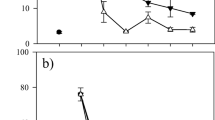Summary
-
1.
Vitamin A was destroyed in cod liver oil as rancidity developed.
-
2.
Vitamin A was destroyed at lower peroxide values when rancidity developed at room temperature than when it was accelerated by aeration at 100°C.
-
3.
It is suggested that not only vitamin A, but other biological properties of oils are not equally affected by rancidity produced in different ways and at different rates, and that peroxide value may not necessarily be parallel to that of other changes which take place in an oil as rancidity develops.
Similar content being viewed by others
Bibliography
Whipple, Dorothy V. Rancid Cod Liver Oil in the Diet of Children. Amer. Journ. Pediatrics, June 1936.
Friderica, L. S. Inactivating Action of Some Fats on Vitamin A in Other Fats. Journ. Biol. Chem. 62, 471 (1925).
Powick, W. C. Inactivation of Vitamin A by Rancid Fat. Journ. Agric. Research, 31, 1017 (1925).
Whipple, Dorothy V. A Syndrome Produced in the Dog by the Inclusion of Oxidized Fat in the Diet. Pr. Soc. Exp. Biol. & Med., 30, 319 (1932).
Whipple, Dorothy V. The Comparative Nutritional Value of Diets Containing Rancid Fat, Neutral Fat and No Fat. Oil & Soap, 10, 288 (1933).
Author information
Authors and Affiliations
About this article
Cite this article
Whipple, D.V. The destruction of vitamin a by rancid cod liver oil. Oil Soap 13, 231–232 (1936). https://doi.org/10.1007/BF02565550
Issue Date:
DOI: https://doi.org/10.1007/BF02565550




